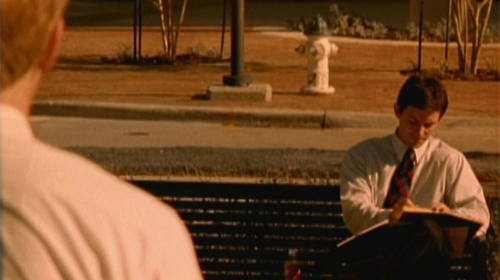Self-Storage as Space-Time Hub: A Review of the Movie Primer
How would you feel if you knew the guy who owned the storage unit right next to yours had a time machine in there and was frequently traveling to the past? You would certainly feel worried, maybe really upset, or even outright angry.
Why would you feel that way? Well, first, people shouldn’t do any activities in a storage unit except for storing and retrieving their possessions. Second, who knows what dangerous materials your rogue time traveling neighbor is using in there. I mean, Doc Brown used plutonium in Back to the Future. Who knows what someone might need to power up a time machine?
The thought nagging at the back of your mind the most, though, the one that might cause you to be downright angry, has to do with why people would travel in time. Sure, Doc Brown wanted to do it to for enjoyment and study, but time travelers in most science fiction want to change history to suit them, from dominating the stock market to preventing some people from ever being born. Remember how Biff reshaped time into his own image in Back To the Future Part II? Nobody wants someone else to have the power to reshape their present by changing the past.
For a story about how a couple of brilliant engineers change time for their own benefit by using time machines they keep in a climate controlled storage unit, check out the 2004 independent Sci-Fi-Drama, Primer.

The premise itself is hilarious, though this film is about as far as you can get from a time-travel comedy like Bill and Ted’s Excellent Adventure or Hot Tub Time Machine. In fact, Primer is probably the most intellectual and hard-to-follow movie I’ve ever seen. Time travel stories are notoriously complex. That’s why in movies and television like Looper or Doctor Who, there’s a moderate amount of exposition to help the audience understand the rules and the consequences of hopping about space-time.
Primer takes the confusion of time travel as far as possible. Of course, that quickly made it my favorite time travel movie. I highly recommend it. You can watch Primer on Hulu, Amazon Instant Video, and Netflix. On Rotten Tomatoes, Primer has a 72% critic rating and an 80% audience rating, showing that, despite the fact that most people need to watch the movie at least twice to get a pretty good understanding of it, most people think it’s a very good movie. At just 1 hour 17 minutes, it’s not tough to watch it twice in an evening. Before you watch it though, let me tell you about three things that will make the movie a smidgen easier to follow. First, the engineers start out working on a machine that will lessen the weight of an object by basically blocking off some of the gravity. They get it to work, but a side effect of the machine leads them to realize they have discovered a means of time travel. Second, there is no exposition in the film. That’s part of what makes it difficult to follow. The story starts with four engineers, Aaron, Abe, Robert, and Phillip. Pretty soon, Aaron and Abe edge the other two out and become the main characters. The voice over that starts in the beginning of the film is Aaron. I feel like this should be obvious when viewing the film, but as it’s his voice over a phone line, it’s difficult to tell who it is at first.
About an hour into the movie, it gets very weird. It’s at that point that almost everyone gets confused and can’t figure out what’s going on the first time they see it. I suggest accepting this and doing your best to figure it out.
Primer was written and directed by Shane Curruth, who also played Aaron in the movie. Though made on an extremely low budget of just $7,000, Primer comes across as artistic and smart, not a B movie at all, and it has gained a strong and well-deserved cult following. The story is also hard science fiction, meaning that it uses plausible science and does not veer into territory like a person fading from time.
After you’ve watched it once, I recommend that you read the page, “Primer Explained,” then watch the movie again. For your third viewing, watch the movie while playing this Primer commentary track. Primer is one of those movies you’ll find yourself thinking a lot about, and if you’re like me, you’ll have a strong desire to really understand the plot. One of the reasons we often don’t enjoy a song too much the first time we hear it, and then enjoy it more when we hear it again, is that we’ve figured it out. Primer is like that.
So, why are they using a self-storage facility to travel in time? Abe chooses this sort of location because there’s enough room to work, it’s climate controlled, and the machines are unlikely to be disturbed. I can almost see an advertisement now. “Need somewhere private to perform your mad science experiments? Self-storage is for you!”

Just in case you’re concerned that your customers may be bending space-time in your facility, or doing anything else they shouldn’t, check out our self-storage security advice in my article 7 Components of The Best Self-Storage Security.If you’re a customer who doesn’t want time machines anywhere near your stuff, you might want to read my article Is Valet Storage Right for You?
If, however, you plan on doing your own time travel experiments, please don’t do so in your self-storage unit. Aaron and Abe didn’t do any harm to the facility itself, but they sure did mess up their own timelines. I guess what I’m trying to say is, set up your time machine somewhere in your own home and be careful not to run into your past or future self.




